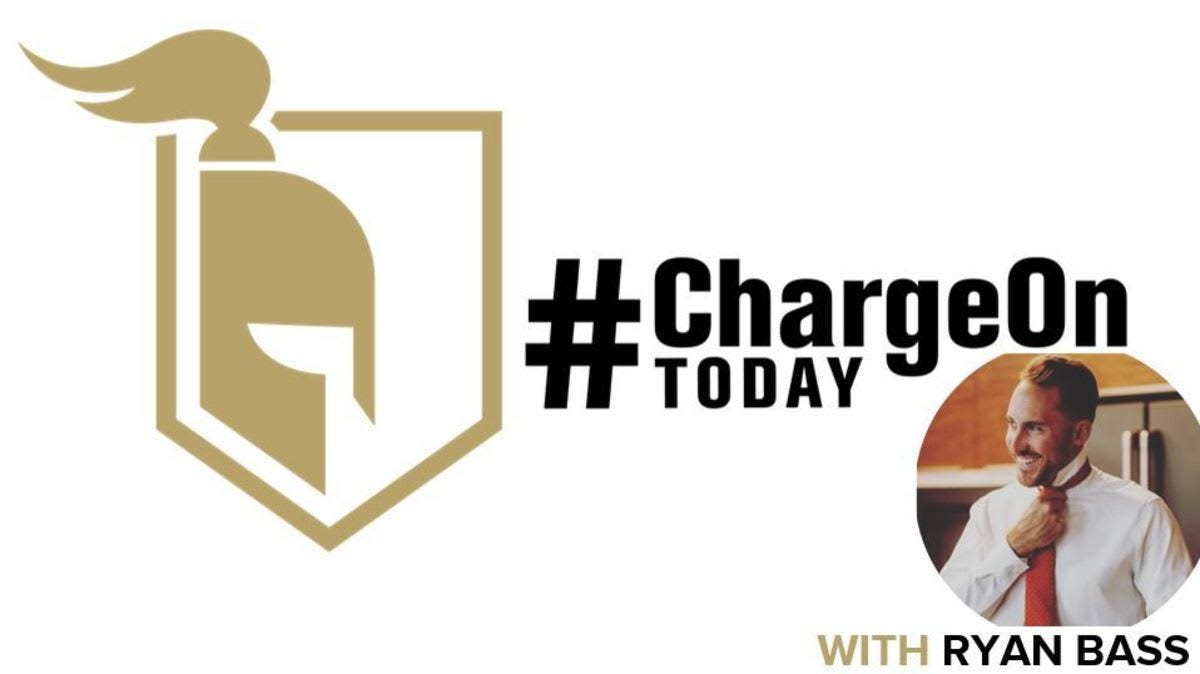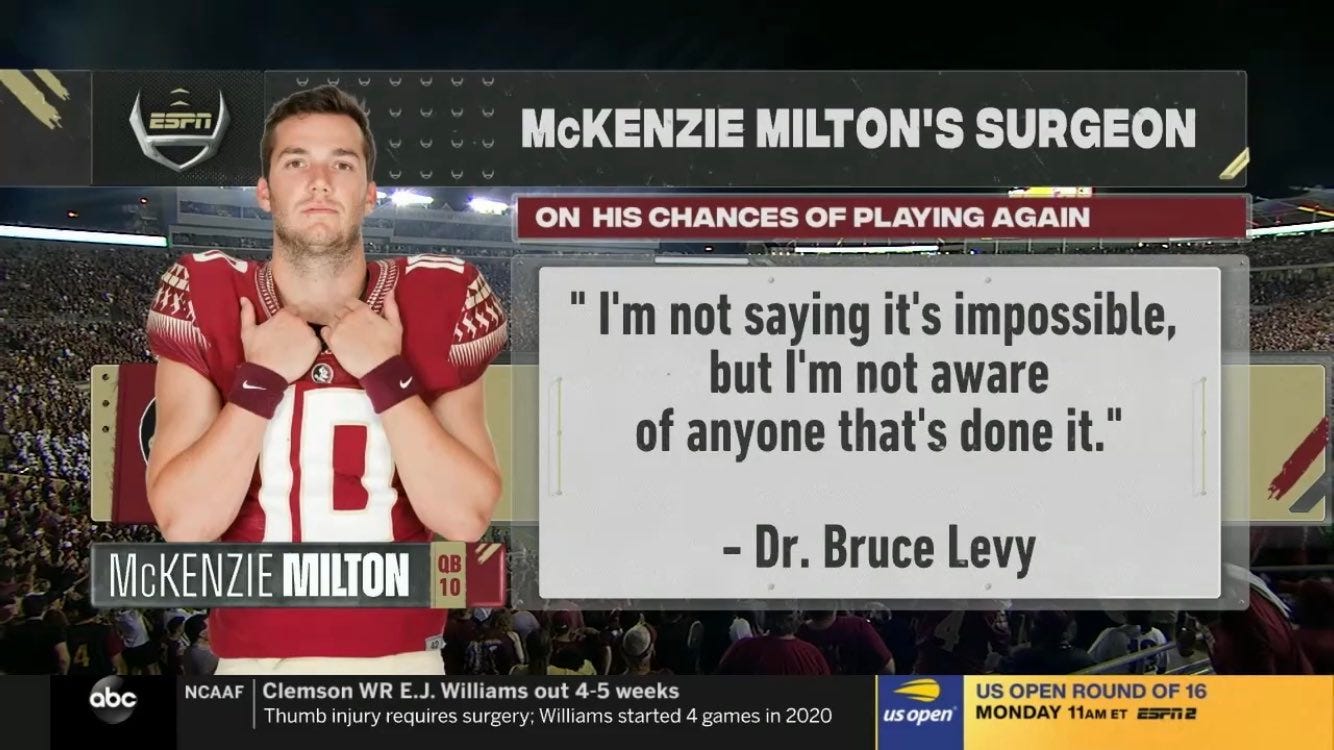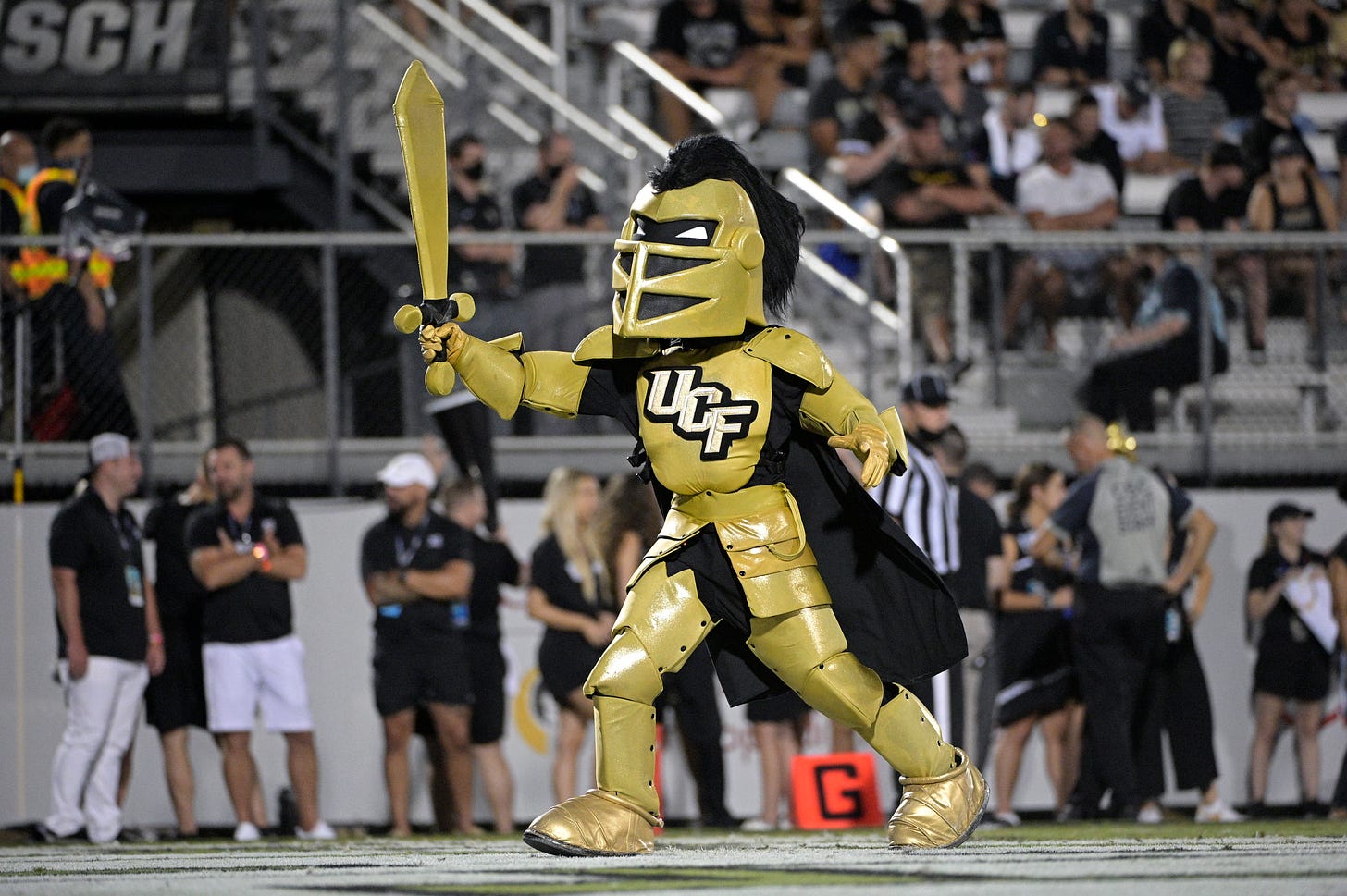KZ comeback, complete ❤️😭 and the biggest week in UCF history is upon us 🚀
Big 12 presidents could vote Monday on inviting four additional members to the conference, and UCF is one of the leading candidates to join. Also, KZ ❤️
While the weather certainly killed the mood, the near 3-hour delay was worth the wait to see that epic comeback at the Bounce House on Thursday, wasn’t it? I’d like to think everyone’s reaction to the historic come-from-behind win over Boise State was like T-Mo’s when Dyllon Lester sealed it with a pick 😂:
Thursday was a massive day for the program’s present and future. A day we may never forget. You can say the same about McKenzie Milton’s comeback on Sunday.
We’ve got a fun newsletter for you today, fam. Let’s jump into it 🤙🏻
Today’s read is 6 minutes ⏲️
Trending in the Kingdom: A KZ comeback for the ages ❤️
It’s one of those moments you’ll never forget where you were when you were watching. I sat on my parents couch and started sobbing at 10:48 p.m on Sunday, September 5. That’s when McKenzie Milton checked into a collegiate game for the first time in 1,017 days.
It was a day that even Milton’s doctors didn’t think was possible when they told him it’d be a struggle to even walk normally again after a catastrophic right leg injury during the UCF-USF game that forced him to be carted off the field and rushed to Tampa General Hospital on November 23, 2018.
“I’m not saying it’s impossible,” Mayo Clinic Dr. Bruce Levy told the Orlando Sentinel about Milton’s chances of ever playing football again. “But I’m not aware of anyone that’s done it.”
Well, now you have, Doc.
Fill me in: It was a moment, a game and a night that 30-for-30 writers were salivating over - and could have been even better if not for a sour ending that resulted in a Florida State loss to Notre Dame.
Milton, who suffered artery and nerve damage to his right leg, a dislocated knee and torn ligaments, wasn’t likely to ever walk normally again, let alone engineer a fourth-quarter comeback on a national stage.
He went 4-for-4 on his first drive after entering when Jordan Travis’ helmet popped off in the fourth quarter, leading the Noles on back-to-back scoring drives against the No. 10 team in the country.
Milton finished the game 5-of-7 passing for 48 yards.
It was special (and nearly brought me to tears) when KZ slung that 22-yard toss on his first play from scrimmage since the injury, which electrified the crowd at Doak Campbell stadium and won the hearts of every human watching from home.

I was on the sidelines for Milton’s gruesome injury nearly three years ago. I remember texting sources and team medical staff at the time, who tried to relay how serious the situation was. There was a realistic possibility that McKenzie would lose his right leg. Doctors were able to save it, but an arduous recovery was ahead and football wasn’t even viewed as a possibility.
The Orlando Sentinel did a beautiful job going in detail with Levy, one of the top orthopedic surgeons in the country, who helped reconstruct Milton’s knee.
“About six weeks after suffering his gruesome injury, Milton was at the Mayo Clinic preparing for a series of grueling surgeries to reconstruct his knee. Levy arranged three surgical teams: one to handle the vascular side of things, one to repair the ligaments and then one team to reconstruct Milton’s, including repairing nerve damage.
For more than seven hours, Levy and his surgical teams worked tirelessly on the right knee of Milton.
Surgeons crafted a vein graft to create a new artery to provide blood flow to the leg using a piece of vein from the other side. Then the surgical teams were able to rebuild the ligaments around the knee joint, and then finally Levy had to reconstruct the knee.
Before the surgery, Milton asked Levy what the odds were that he could play football again.
“I had gone through all of the college and NFL databases on prior players that had dislocated their knee,” said Levy. “And there’s one or two that were able to get back to playing, but none with this specific ligament, vascular and nerve injury.”

Milton didn’t care what the odds were, and he defied them every step of the way. He ran the scout team at UCF last August, but with Dillon Gabriel entrenched as QB1, he transferred to Florida State following the season to compete for the starting job. I think he earned it after tonight.
There are special moments you long remember from sports, but I’m not sure any will top what I got a chance to witness on Sunday night. At 10:48 p.m on Sept. 5, the McKenzie Milton comeback was complete.
Here’s just a few of my favorite tweets about Milton from the night:


Deeper Dive 🤿:
Paradise lost: Why McKenzie Milton still strives to play football again after horrific injury (Yahoo.com)
McKenzie Milton’s orthopedic surgeon details the FSU QB’s long road back to football (Orlando Sentinel)
Oh hey, it’s Big 12 invite week 💪
This isn’t meant to be hyperbolic, but we’re about to embark on possibly the biggest week in UCF athletics history. The “sleeping giant” will finally be awoken, joining the ranks of college football’s power conferences after years of being on the outside looking in.
Here’s the scoop: According to multiple reports, the Big 12 conference is expanding as soon as this week, and they’re focusing on four key programs to potentially issue invitations: BYU, Cincinnati, Houston and UCF. The news first broke on Thursday, the morning of UCF’s season opener.
All four schools are expected to apply and could be approved invitations by the end of this week, according to Sports Illustrated’s Ross Dellinger and Pat Forde.
“The league has the eight votes needed for expansion…In this scenario, the four teams will join the league by 2023 or, at the very latest, 2024, and may even compete alongside Oklahoma and Texas before those two powerhouses depart for the SEC, making for a couple of awkward seasons in a 14-team Big 12.”
Of course, all of this was sparked by Texas and OU’s exit to the SEC, the new ACC, Big Ten and Pac-12 “Alliance”, plus the Pac-12’s decision not to explore expansion. That put the Big 12 in a dire position: Expand or risk losing their Power 5 autonomous status after the College Football Playoff contract expires in 2025.
So, what happens next? 💌 Presumably, things could escalate pretty quickly, but UCF likely won’t be able to leave the American Athletic Conference until 2023 at the earliest.
The Big 12 Conference bylaws say that a supermajority vote of 80 percent of the league’s board of directors is required to admit new members. The Athletic is reporting they’ll have the votes necessary to move forward.
UCF, BYU, Cincinnati and Houston could be invited as early as Sept. 10, according to the report.
The trio of AAC schools are required to give a 27-month notice if they intend to leave the league, along with a $10 million dollar exit fee, but that figure could increase to flee early. BYU, as an independent, could move a lot quicker in joining the Big 12.
Why is this such a big deal? 💰 There’s a bevy of benefits for UCF joining a Power 5 conference, but the financials are the biggest lift. Right now, they net about $7 million annually in distribution revenue. Joining the Big 12 has the potential to triple that, on the low end.
Currently, Big 12 schools average a payout of $37 million annually per institution, but that’s going to drop with Texas and Oklahoma leaving, as CBS Sports notes.
“Industry sources tell CBS Sports that the Big 12 lost at least 40% of its value with the departure of Texas and Oklahoma. However, the reconfigured Big 12 with four additions could earn $20 million-$25 million per season, softening the financial blow.”
"These are the four that will allow us to enter that [CFP] future negotiation favorably," a source within the Big 12 said. "What we're trying to do will give us the best opportunity to retain our CFP status and our Power Five status."
The other important key here is UCF’s opportunity to finally compete for a spot in the Playoff, which was expected to expand to 12 teams, but that could be on hold for now. Joining the Big 12 would give the Knights a much better opportunity to sneak into the four-team model, especially if it stayed in place beyond the 2025 season.
According to the S&P rankings, the reconfigured Big 12 would rank as a tougher conference than the ACC and Pac-12, which have both made appearances in the Playoff the last few years.
What would a Big 12 look like with UCF in it? 🗺️ They’ll be the furthest east of any program in the conference, so there will be some airline miles logged visiting spots like Lubbock, Lawrence, Aimes and Provo.
Competition-wise, they’d certainly play a much tougher in-conference schedule. Even if you remove Oklahoma and Texas, there have been 20 ten-win seasons in the Big 12 since 2010, with Oklahoma State (6), Baylor (5) and TCU (5) having the most.
UCF has 6 ten-win seasons over that same span, so it would be tied for most in the Big 12 and is nearly as many as other newcomers BYU (2), Cincinnati (4) and Houston (2) combined.
What about USF? 🤘 Welp, I guess karma really does come back around. This time, it’s South Florida being shut out of the major conference and UCF leaving its rival behind. USF picked a bad time to be bad at football.
Look, I think UCF and USF should be inseparable because of the natural rivalry that divides the two schools. This sport was built on the hatred between rival schools and UCF-USF should be a package deal, but it’s hard to feel bad for them after ex-President Judy Genshaft blocked UCF from joining the Big East a decade ago amid some pretty petty politics.
Apparently, the deciding factors in choosing the four additional members were their strong TV presence, high levels of play and recruiting advantages. The Bulls check off two of the three, but they’re missing the big one, going 63-71 since 2010, including five wins in their last 17 games. Recency bias matters in expansion and USF is now left out in the cold.
We’ll see how quickly things evolve this week, but it could truly be a banner one for the future of UCF athletics. Time to #ChargeOn into the Power 5.
We’ve waited long enough.













